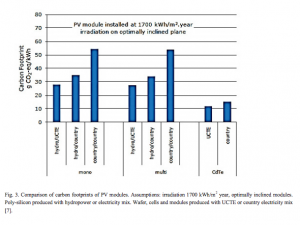The manufacturing and transportation of solar PV panels posses direct and indirect human health hazards through the release of harmful elements, and possible contributions to climate change’s current and potential environmental impacts.
Manufacturing and transportation practices can be addressed in order to limit the environmental impact.
The figure below shows how the electricity mix involved in the manufacturing process can significantly diminish the carbon footprint associated with PV production.
If manufacturing was 100% renewable, the only environmental impact would be from the unlikely release of pollutants.

Figure: Shows carbon footprint (g CO2/kwh) for three types of PV technologies and three corresponding electricity mixes with hydroelectric and conventional on the far left and right respectively [1]
Sources of Environmental Injustice?
China has now become the leading manufacturer of solar PV with roughly 95% of their products as exports to developed countries such as the United States. [1]
This distance between consumer and manufacturer can show an environmental injustice if the manufacturers or local residents near the production facility experience some health impact as a result of pollution.
In a singular case in 2008 at Gaolong, China, it was discovered that a polysilicon facility was dumping silicon tetrachloride into neighboring rivers, hurting crop yields and “inflaming the eyes and throats of nearby residents.” [2]
Immediately afterwards policy was instituted requiring that companies recycle at least 98.5% of silicon tetrachloride. [2] Even though the issue was addressed, this example highlights the ways in which PV production all over the world can create injustice.
Author: Kevin Jackson
Editor:Hannah Goldstein, Abby Studen
Sources
[1] Dubey, S., & Jadhav, B.Z., (2012) Socio-Economic and Environmental Impacts of Silicon Based Photovoltaic (PV) Technologies. Energy Procedia. 33, 322-334.
[2] Mulvaney, D., (2014). Solar Energy Isn’t Always as Green as You Think.